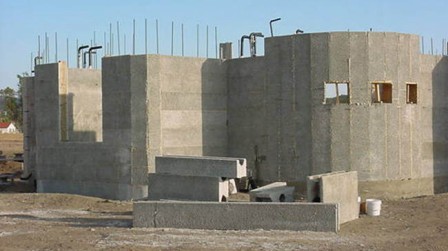RASTRA
 |
| Photos courtesy of RASTRA |
RASTRA, a unique brand of Composite Insulating Concrete Form (ICF), makes concrete panels of 85% recycled expanded polystyrene (EPS) and 15% cement. A standard panel is up to 10 feet long, 15 or 30 inches wide, and 8.5 to 14 inches thick. The EPS content gives a RASTRA panel light weight and high insulating value; structural strength comes from rebar and concrete that are inserted through vertical and horizontal channels built into the panel's shape. When the inserted concrete hardens around the rebar, it forms a strong, interlocking gridwork. The combination of vertical and horizontal channels allows RASTRA panels to be placed either horizontal, usually for straight walls, or vertical, which simplifies curved walls. Pre-fab, complete walls up to 25 feet long are also available.
 |
Advantages of RASTRA:
- RASTRA panels are quick to assemble into walls and light enough to be handled without a crane.
- RASTRA panels are produced from 85% recycled material, without releasing any fumes or particles, and using no heat. All production waste is recycled back into RASTRA, as can be leftovers from the construction site.
- Because RASTRA does not wick or hold moisture as does ordinary concrete or wood, it is inhospitable to mold and will not break down due to rot or freeze-thaw cycles.
- Compared to conventional stud-and-batt walls, RASTRA walls form a much more consistent insulation barrier with far less air infiltration, giving them an effective whole-wall performance up to R-48.
- RASTRA houses are seven times stronger than conventional wood structures in surviving earthquakes.
- A RASTRA panel exposed to a 2000-degree flame for five hours does not ignite, and the other side of the panel only shows a 7-degree rise in temperature. Even if some of the EPS melts, it emits far less toxic gas than burning wood.
- Unlike wood, RASTRA panels will not expand, contract, warp, or get eaten by termites, reducing the need for repairs and repainting.
Below is a house that makes great use of vertical RASTRA panels formed into curved walls.
For much more information, see RASTRA.
 |
